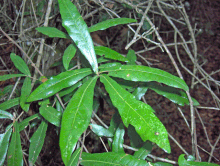
Quercus montana, the chestnut oak, is a species of oak in the white oak group, Quercus sect. Quercus. It is native to the eastern United States, where it is one of the most important ridgetop trees from southern Maine southwest to central Mississippi, with an outlying northwestern population in southern Michigan. It is also sometimes called rock oak because of its presence in montane and other rocky habitats.

Quercus palustris, also called pin oak, swamp oak, or Spanish oak, is a tree in the red oak section of the genus Quercus. Pin oak is one of the most commonly used landscaping oaks in its native range due to its ease of transplant, relatively fast growth, and pollution tolerance.

Quercus muehlenbergii, the chinquapinoak, is a deciduous species of tree in the white oak group. The species was often called Quercus acuminata in older literature. Quercus muehlenbergii is native to eastern and central North America. It ranges from Vermont to Minnesota, south to the Florida panhandle, and west to New Mexico in the United States. In Canada it is only found in southern Ontario, and in Mexico it ranges from Coahuila south to Hidalgo.

Quercus velutina, the black oak, is a species of oak in the red oak group, native and widespread in eastern and central North America. It is sometimes called the eastern black oak.

Quercus bicolor, the swamp white oak, is a North American species of medium-sized trees in the beech family. It is a common element of America's north central and northeastern mixed forests. It can survive in a variety of habitats. It forms hybrids with bur oak where they occur together in the wild.

Quercus virginiana, also known as the southern live oak, is an evergreen oak tree endemic to the Southeastern United States. Though many other species are loosely called live oak, the southern live oak is particularly iconic of the Old South. Many very large and old specimens of live oak can be found today in the Deep South region of the United States.

Live oak or evergreen oak is any of a number of oaks in several different sections of the genus Quercus that share the characteristic of evergreen foliage. These oaks are generally not more closely related to each other than they are to other oaks.

Quercus laevis, the turkey oak, is a member of the red oak group of oaks. It is native to the southeastern United States. The name turkey oak derives from the resemblance of the leaves to a turkey's foot. A Turkish and southern European species Quercus cerris is also commonly referred to as Turkey oak, so Quercus laevis is sometimes referred to as American turkey oak to distinguish it from the European species.

Quercus agrifolia, the California live oak, or coast live oak, is a highly variable, often evergreen oak tree, a type of live oak, native to the California Floristic Province. It may be shrubby, depending on age and growing location, but is generally a medium-sized tree. It grows west of the Sierra Nevada mountain range from Mendocino County, California, south to northern Baja California in Mexico. It is classified in the red oak section of oaks.
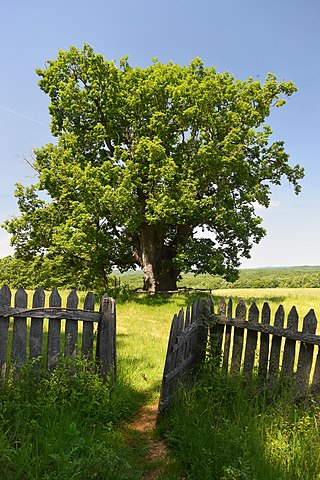
Quercus frainetto, commonly known as the Hungarian oak, is a species of oak, native to southeastern Europe and Turkey. It is classified in Quercus sect. Quercus.

Quercus laurifolia is a medium-sized semi-evergreen oak in the red oak section Quercus sect. Lobatae. It is native to the southeastern and south-central the United States.
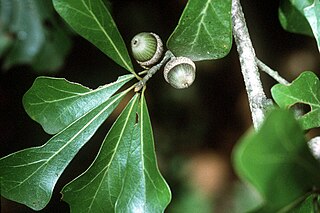
Quercus nigra, the water oak, is an oak in the red oak group, native to the eastern and south-central United States, found in all the coastal states from New Jersey to Texas, and inland as far as Oklahoma, Kentucky, and southern Missouri. It occurs in lowlands and up to 450 meters in elevation.
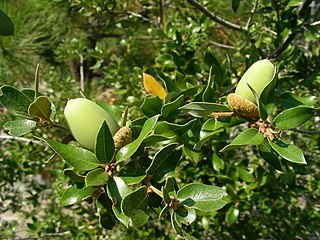
Quercus chrysolepis, commonly termed canyon live oak, canyon oak, golden cup oak or maul oak, is a North American species of evergreen oak that is found in Mexico and in the western United States, notably in the California Coast Ranges. This tree is often found near creeks and drainage swales growing in moist cool microhabitats. Its leaves are a glossy dark green on the upper surface with prominent spines; a further identification arises from the leaves of canyon live oak being geometrically flat.

Florida sand pine scrub is an endangered subtropical forest ecoregion found throughout Florida in the United States. It is found on coastal and inland sand ridges and is characterized by an evergreen xeromorphic plant community dominated by shrubs and dwarf oaks. Because the low-nutrient sandy soils do not retain moisture, the ecosystem is effectively an arid one. Wildfires infrequently occur in the Florida scrub. Most of the annual rainfall falls in summer. It is endangered by residential, commercial and agricultural development, with the largest remaining block in and around the Ocala National Forest. Lake Wales Ridge National Wildlife Refuge also holds a high proportion of remaining scrub habitat, while the Archbold Biological Station near Lake Placid contains about 20 km2 (7.7 sq mi) of scrub habitat and sponsors biological research on it.

Quercus dumosa is a species of plant in the family Fagaceae, belonging to the white oak section of the oak genus (Quercus). This tree goes by the common names coastal sage scrub oak and Nuttall's scrub oak.
Laurel oak may refer to two species of trees native to the southeastern United States:

The Southeastern conifer forests are a temperate coniferous forest ecoregion of the southeastern United States. It is the largest conifer forest ecoregion east of the Mississippi River. It is also the southernmost instance of temperate coniferous forest within the Nearctic realm.

Quercus myrtifolia, the myrtle oak, is a North American species of oak. It is native to the southeastern United States. It is often found in coastal areas on sandy soils.
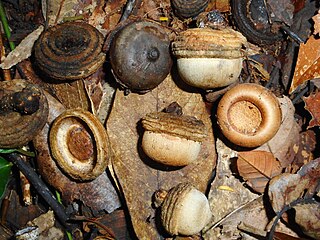
Quercus kerrii is an uncommon Asian species of tree in the family Fagaceae. It is native to Thailand and Vietnam. There are also populations in southern China that according to some authors belong to Q. kerrii but considered by others to belong to a different species, Q. helferiana.Quercus kerrii is placed in subgenus Cerris, section Cyclobalanopsis. Its Chinese name is mao ye qing gang.
Quercus langbianensis is an uncommon oak tree species in the family Fagaceae. It is placed in subgenus Cerris, section Cyclobalanopsis, the ring-cupped oaks. These differ from other Quercus groups in that they have acorns with distinctive cups: usually with substantial rings, made-up of scales that have grown together. This species can be found in sub-tropical and tropical seasonal forests of Cambodia, China and Vietnam.
